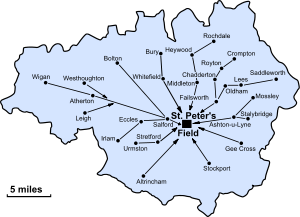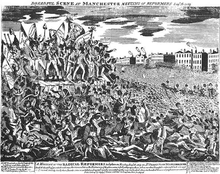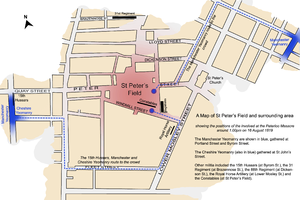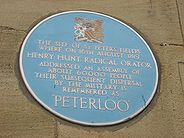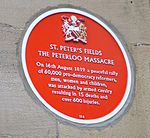- Peterloo Massacre
-
Coordinates: 53°28′41″N 2°14′49″W / 53.478°N 2.247°W
Peterloo Massacre Part of the history of Manchester 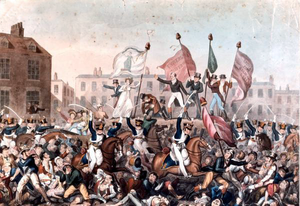
A painting of the Peterloo Massacre published by Richard CarlileDate 16 August 1819 Location St Peter's Field, Manchester, England Result 15 killed
650 injuredThe Peterloo Massacre (or Battle of Peterloo) occurred at St Peter's Field, Manchester, England, on 16 August 1819, when cavalry charged into a crowd of 60,000–80,000 that had gathered to demand the reform of parliamentary representation.
The end of the Napoleonic Wars in 1815 had resulted in periods of famine and chronic unemployment, exacerbated by the introduction of the first of the Corn Laws. By the beginning of 1819 the pressure generated by poor economic conditions, coupled with the lack of suffrage in northern England, had enhanced the appeal of political radicalism. In response, the Manchester Patriotic Union, a group agitating for parliamentary reform, organised a demonstration to be addressed by the well-known radical orator Henry Hunt.
Shortly after the meeting began, local magistrates called on the military authorities to arrest Hunt and several others on the hustings with him, and to disperse the crowd. Cavalry charged into the crowd with sabres drawn, and in the ensuing confusion, 15 people were killed and 400–700 were injured. The massacre was given the name Peterloo in ironic comparison to the Battle of Waterloo, which had taken place four years earlier.
Historian Robert Poole has called the Peterloo Massacre one of the defining moments of its age. In its own time, the London and national papers shared the horror felt in the Manchester region, but Peterloo's immediate effect was to cause the government to crack down on reform, with the passing of what became known as the Six Acts. It also led directly to the foundation of The Manchester Guardian (now The Guardian), but had little other effect on the pace of reform. In a survey conducted by The Guardian in 2006, Peterloo came second to the Putney Debates as the event from British history that most deserved a proper monument or a memorial. Peterloo is commemorated by a plaque close to the site, a replacement for an earlier one that was criticised as being inadequate as it did not reflect the scale of the massacre.
Contents
Background
Suffrage
In 1819, Lancashire was represented by two Members of Parliament (MPs). Voting was restricted to the adult male owners of freehold land valued at 40 shillings or more – the equivalent of about £80 as of 2008[1] – and votes could only be cast at the county town of Lancaster, by a public spoken declaration at the hustings. Constituency boundaries were out of date, and the so-called "rotten boroughs" had a hugely disproportionate influence on the membership of the Parliament of the United Kingdom compared to the size of their populations: Old Sarum in Wiltshire, with one voter, elected two MPs,[2] as did Dunwich in Suffolk, which by the early 19th century had almost completely disappeared into the sea.[3] The major urban centres of Manchester, Salford, Bolton, Blackburn, Rochdale, Ashton-under-Lyne, Oldham and Stockport, with a combined population of almost one million, were represented by either the two county MPs for Lancashire, or the two for Cheshire in the case of Stockport. By comparison, more than half of all MPs were elected by a total of just 154 voters.[2] These inequalities in political representation led to calls for reform.
Economic conditions
After the end of the Napoleonic Wars in 1815, a brief boom in textile manufacture was followed by periods of chronic economic depression, particularly among textile weavers and spinners.[4] Weavers who could have expected to earn 15 shillings for a six-day week in 1803, saw their wages cut to 5 shillings or even 4s 6d by 1818.[5] The industrialists, who were cutting wages without offering relief, blamed market forces generated by the aftershocks of the Napoleonic Wars.[5] Exacerbating matters were the Corn Laws, the first of which was passed in 1815, imposing a tariff on foreign grain in an effort to protect English grain producers. The cost of food rose as people were forced to buy the more expensive and lower quality British grain, and periods of famine and chronic unemployment ensued, increasing the desire for political reform both in Lancashire and in the country at large.[6][7]
By the beginning of 1819 the pressure generated by poor economic conditions was at its peak and had enhanced the appeal of political radicalism among the cotton loom weavers of south Lancashire.[4] In response, coupled with the lack of suffrage in northern England, a "great assembly" was organised by the Manchester Patriotic Union, a group agitating for parliamentary reform. The secretary of the union, Joseph Johnson, wrote to the well-known radical orator Henry Hunt asking him to chair a large meeting planned for Manchester on 2 August 1819. In his letter Johnson wrote:
Nothing but ruin and starvation stare one in the face [in the streets of Manchester and the surrounding towns], the state of this district is truly dreadful, and I believe nothing but the greatest exertions can prevent an insurrection. Oh, that you in London were prepared for it.[8]
Unknown to either Johnson or Hunt, the letter was intercepted by government spies and copied before being sent on to its destination. The contents were interpreted to mean that an insurrection was being planned, and the government immediately responded by ordering the 15th Hussars to Manchester.[9]
 Samuel Bamford led a group from his native Middleton to St Peter's Field. Following his imprisonment for "inciting a riot", Bamford emerged as a prominent voice for radical reform.
Samuel Bamford led a group from his native Middleton to St Peter's Field. Following his imprisonment for "inciting a riot", Bamford emerged as a prominent voice for radical reform.
The mass public meeting planned for 2 August was delayed until 9 August. Announcing the delay, the Manchester Observer reported that the intention of the meeting was "to take into consideration the most speedy and effectual mode of obtaining Radical reform in the Common House of Parliament" and "to consider the propriety of the 'Unrepresented Inhabitants of Manchester' electing a person to represent them in Parliament".[10] The local magistrates, under the leadership of William Hulton, had already been advised by the acting Home Secretary, Henry Hobhouse, that "the election of a Member of Parliament without the King's writ" was a serious misdemeanour,[11] encouraging them to declare the assembly illegal.[12]
Rehearsals
Although banning the 9 August meeting had been intended to discourage the radicals entirely, Hunt and his followers were determined to assemble. A new meeting was organised for 16 August,[12] after the Home Secretary, Lord Sidmouth, had written to the magistrates instructing them that it was not the intention to elect an MP that was illegal, but the execution of that intention.[13]
The press had frequently mocked previous meetings of working men because of their ragged, dirty appearance and disorganised conduct. The organisers were determined that those attending the meeting at St Peter's Field would be neatly turned out and would march to the event in good order.[14] Samuel Bamford, a local radical who led the Middleton contingent to the assembly, wrote that "It was deemed expedient that this meeting should be as morally effective as possible, and, that it should exhibit a spectacle such as had never before been witnessed in England."[4] Instructions were given to the various committees forming the contingents that "Cleanliness, Sobriety, Order and Peace" and a "prohibition of all weapons of offence or defence" were to be observed throughout the demonstration.[15] Each contingent was drilled and rehearsed in the fields of the townships around Manchester, further adding to the concerns of the authorities.[12] One spy reported that "seven hundred men drilled at Tandle Hill as well as any army regiment would".[12] A royal proclamation forbidding the practice of drilling was posted in Manchester on 3 August.[13]
Assembly
Contingents
sent to St Peter's Field[16]
Use a cursor to explore this imagemap.Altrincham Middleton 3,000[17] Ashton-under-Lyne 2,000[17] Mossley Atherton Oldham 6,000–10,000[17][18] Bolton Rochdale 3,000[17] Bury 3,000[17] Royton Chadderton Saddleworth Crompton Salford Eccles Stalybridge Failsworth Stretford Gee Cross Stockport 1,500–5,000[17][19] Heywood Urmston Irlam Westhoughton Lees Whitefield Leigh Wigan Preparations
St Peter's Field was a croft (an open piece of land) alongside Mount Street which was being cleared to enable the last section of Peter Street to be constructed. Piles of brushwood had been placed at the end of the field nearest to the Friends Meeting House, but the remainder of the field was clear.[20] Thomas Worrell, Manchester's Assistant Surveyor of Paving, arrived to inspect the field at 7:00 am. His job was to remove anything that might be used as a weapon, and he duly had "about a quarter of a load" of stones carted away.[21]
Monday, 16 August 1819, was a hot summer's day, with a cloudless blue sky. The fine weather almost certainly increased the size of the crowd significantly; marching from the outer townships in the cold and rain would have been a much less attractive prospect.[22]
The Manchester magistrates met at 9:00 am, to breakfast at the Star Inn on Deansgate and to consider what action they should take on Henry Hunt's arrival at the meeting. By 10:30 am they had come to no conclusions, and moved to a house on the southeastern corner of St Peter's Field, from where they planned to observe the meeting.[23] They were concerned that it would end in a riot, or even a rebellion, and had arranged for a substantial number of regular troops and militia yeomanry to be deployed. The military presence comprised 600 men of the 15th Hussars; several hundred infantrymen; a Royal Horse Artillery unit with two six-pounder (2.7 kg) guns; 400 men of the Cheshire Yeomanry; 400 special constables; and 120 cavalry of the Manchester and Salford Yeomanry, relatively inexperienced militia recruited from among local shopkeepers and tradesmen, the most numerous of which were publicans.[24] The Yeomanry were variously described as "younger members of the Tory party in arms",[25] and as "hot-headed young men, who had volunteered into that service from their intense hatred of Radicalism".[26]
The British Army in the north was under the overall command of General Sir John Byng. When he had initially learned that the meeting was scheduled for 2 August he had written to the Home Office stating that he hoped the Manchester magistrates would show firmness on the day:
I will be prepared to go there, and will have in that neighbourhood, that is within an easy day's march, 8 squadron of cavalry, 18 companies of infantry and the guns. I am sure I can add to the Yeomanry if requisite. I hope therefore the civil authorities will not be deterred from doing their duty.[27]
The revised meeting date of 16 August, however, coincided with the horse races at York, a fashionable event at which Byng had entries in two races. He once again wrote to the Home Office, saying that although he would still be prepared to be in command in Manchester on the day of the meeting if it was thought really necessary, he had absolute confidence in his deputy commander, Lieutenant Colonel Guy L'Estrange.[28]
Meeting
The crowd that gathered in St Peter's Field arrived in disciplined and organised contingents. Each village or chapelry was given a time and a place to meet, from where its members were to proceed to assembly points in the larger towns or townships, and from there on to Manchester.[29] Contingents were sent from all around the region, the largest and "best dressed"[18] of which was a group of 10,000 who had travelled from Oldham Green, comprising people from Oldham, Royton (which included a sizable female section), Crompton, Lees, Saddleworth and Mossley.[18] Other sizable contingents marched from Middleton and Rochdale (6,000 strong) and Stockport (1,500–5,000 strong).[19] Reports of the size of the crowd at the meeting vary substantially. Contemporaries estimated it from 30,000 to as many as 150,000; modern estimates are 60,000–80,000.[30] Scholar Joyce Marlow describes the event as "The most numerous meeting that ever took place in Great Britain" and elaborates that the generally accepted figure of 60,000 would have been 6% of the population of Lancashire, or half the population of the immediate area around Manchester.[18]
The assembly was intended by its organisers and participants to be a peaceful meeting; Henry Hunt had exhorted everyone attending to come "armed with no other weapon but that of a self-approving conscience",[31] and many were wearing their "Sunday best" clothes.[20] Samuel Bamford recounts the following incident, which occurred as the Middleton contingent reached the outskirts of Manchester:
On the bank of an open field on our left I perceived a gentleman observing us attentively. He beckoned me, and I went to him. He was one of my late employers. He took my hand, and rather concernedly, but kindly, said he hoped no harm was intended by all those people who were coming in. I said "I would pledge my life for their entire peaceableness." I asked him to notice them, "did they look like persons wishing to outrage the law? were they not, on the contrary, evidently heads of decent working families? or members of such families?" "No, no," I said, "my dear sir, and old respected master, if any wrong or violence take place, they will be committed by men of a different stamp from these." He said he was very glad to hear me say so; he was happy he had seen me, and gratified by the manner in which I had expressed myself. I asked, did he think we should be interrupted at the meeting? he said he did not believe we should; "then," I replied, "all will be well"; and shaking hands, with mutual good wishes, I left him, and took my station as before.[32]Although some observers, like the Rev. W. R. Hay, chairman of the Salford Quarter Sessions, claimed that "The active part of the meeting may be said to have come in wholly from the country",[16] others such as John Shuttleworth, a local cotton manufacturer, estimated that most were from Manchester, a view that would subsequently be supported by the casualty lists. Of the casualties whose residence was recorded, 61% lived within a three-mile radius of the centre of Manchester.[33] Some groups carried banners with texts like "No Corn Laws", "Annual Parliaments", "Universal suffrage" and "Vote By Ballot". The only banner known to have survived is in Middleton Public Library. It was carried by Thomas Redford, who was injured by a yeomanry sabre. Made of green silk embossed with gold lettering, one side of the banner is inscribed "Liberty and Fraternity" and the other "Unity and Strength".[34]
At about noon, several hundred special constables were led onto the field. They formed two lines in the crowd a few yards apart, in an attempt to form a corridor through the crowd between the house where the magistrates were watching and the hustings, two waggons lashed together. Believing that this might be intended as the route by which the magistrates would later send their representatives to arrest the speakers, some members of the crowd pushed the waggons away from the constables, and pressed around the hustings to form a human barrier.[35]
Hunt's carriage arrived at the meeting shortly after 1:00 pm, and he made his way to the hustings. Alongside Hunt on the speakers' stand were John Knight, a cotton manufacturer and reformer, Joseph Johnson, the organiser of the meeting, John Thacker Saxton, managing editor of the Manchester Observer, the publisher Richard Carlile, and George Swift, reformer and shoemaker. There were also a number of reporters, including John Tyas of The Times, John Smith of the Liverpool Echo and Edward Baines Jr, the son of the editor of the Leeds Mercury.[36] By this time St Peter's Field, an area of 14,000 square yards (11,706 m2), was packed with tens of thousands of men, women and children. The crowd around the speakers was so dense that "their hats seemed to touch"; large groups of curious spectators gathered on the outskirts of the crowd. The rest of Manchester was like a ghost town, the streets and shops were empty.[37]
Charge
When I wrote these two letters, I considered at that moment that the lives and properties of all the persons in Manchester were in the greatest possible danger. I took this into consideration, that the meeting was part of a great scheme, carrying on throughout the country.[38]
“”William HultonWilliam Hulton, the chairman of the magistrates watching from the house on the edge of St Peter's Field, saw the enthusiastic reception that Hunt received on his arrival at the assembly, and it encouraged him to action. He issued an arrest warrant for Henry Hunt, Joseph Johnson, John Knight, and James Moorhouse. On being handed the warrant the Chief Constable, Jonathan Andrews, offered his opinion that the press of the crowd surrounding the hustings would make military assistance necessary for its execution. Hulton then wrote two letters, one to Major Thomas Trafford, the commanding officer of the Manchester and Salford Yeomanry Cavalry, and the other to the overall military commander in Manchester, Lieutenant Colonel Guy L'Estrange. The contents of both notes were similar:[39]
Sir, as chairman of the select committee of magistrates, I request you to proceed immediately to no. 6 Mount Street, where the magistrates are assembled. They consider the Civil Power wholly inadequate to preserve the peace. I have the honour, & c. Wm. Hulton.[38]—
Letter sent by William Hulton to Major Trafford of the Manchester and Salford Yeomanry CavalryThe notes were handed to two horsemen who were standing by. The Manchester and Salford Yeomanry were stationed just a short distance away in Portland Street, and so received their note first. They immediately drew their swords and galloped towards St Peter's Field. One trooper, in a frantic attempt to catch up, knocked down a woman in Cooper Street, causing the death of her child when he was thrown from her arms;[40] two-year-old William Fildes was the first casualty of Peterloo.[41]
Sixty cavalrymen of the Manchester and Salford Yeomanry, led by Captain Hugh Hornby Birley, a local factory owner, arrived at the house from where the magistrates were watching; some reports allege that they were drunk.[42] Andrews, the Chief Constable, instructed Birley that he had an arrest warrant which he needed assistance to execute. Birley was asked to take his cavalry to the hustings to allow the speakers to be removed; it was by then about 1:40 pm.[43]
The route towards the hustings between the special constables was narrow, and as the inexperienced horses were thrust further and further into the crowd they reared and plunged as people tried to get out of their way.[40] The arrest warrant had been given to the Deputy Constable, Joseph Nadin, who followed behind the yeomanry. As the cavalry pushed towards the speakers' stand they became stuck in the crowd, and in panic started to hack about them with their sabres.[44] On his arrival at the stand Nadin arrested Hunt, Johnson and a number of others including John Tyas, the reporter from The Times.[45] According to Tyas the yeomanry's progress through the crowd had provoked a hail of bricks and stones, and caused them to lose "all command of temper".[46] Their mission to execute the arrest warrant having been achieved, they then set about destroying the banners and flags carried by the crowd.[46]
From his vantage point William Hulton perceived the unfolding events as an assault on the yeomanry, and on L'Estrange's arrival at 1:50 pm, at the head of his hussars, he ordered them into the field to disperse the crowd with the words: "Good God, Sir, don't you see they are attacking the Yeomanry; disperse the meeting!"[47] The 15th Hussars formed themselves into a line stretching across the eastern end of St Peter's Field, and charged into the crowd. At about the same time the Cheshire Yeomanry charged from the southern edge of the field.[48] At first the crowd had some difficulty in dispersing, as the main exit route into Peter Street was blocked by the 88th Regiment of Foot, standing with bayonets fixed. One officer of the 15th Hussars was heard trying to restrain the by now out of control Manchester and Salford Yeomanry, who were "cutting at every one they could reach": "For shame! For shame! Gentlemen: forbear, forbear! The people cannot get away!"[49]
However, within ten minutes the crowd had been dispersed, at the cost of 11 dead and over 600 injured. Only the wounded, their helpers, and the dead were left behind. A woman living nearby said she saw "a very great deal of blood".[12] For some time afterwards there was rioting in the streets, most seriously at New Cross, where troops fired on a crowd attacking a shop belonging to someone rumoured to have taken one of the women reformers' flags as a souvenir. Peace was not restored in Manchester until the next morning, and in Stockport and Macclesfield rioting continued on the 17th.[50] There was also a major riot in Oldham that day, during which one person was shot and wounded.[12]
Victims
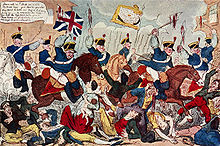 A caricature by George Cruikshank depicting the charge upon the rally; text reads: "Down with 'em! Chop em down my brave boys: give them no quarter they want to take our Beef & Pudding from us! ---- & remember the more you kill the less poor rates you'll have to pay so go at it Lads show your courage & your Loyalty!"
A caricature by George Cruikshank depicting the charge upon the rally; text reads: "Down with 'em! Chop em down my brave boys: give them no quarter they want to take our Beef & Pudding from us! ---- & remember the more you kill the less poor rates you'll have to pay so go at it Lads show your courage & your Loyalty!"
The exact number of those killed and injured at Peterloo has never been established with certainty.[51] Sources claim 11–15 killed and 400–700 injured. The Manchester Relief Committee, a body set up to provide relief for the victims of Peterloo, gave the number of injured as 420, while Radical sources listed 500.[51] The true number is difficult to estimate, as many of the wounded hid their injuries for fear of retribution by the authorities.[52] Three of William Marsh's six children worked in the factory belonging to Captain Hugh Birley of the Manchester Yeomanry, and lost their jobs because their father had attended the meeting.[53] James Lees was admitted to Manchester Infirmary with two severe sabre wounds to the head, but was refused treatment and sent home after refusing to agree with the surgeon's insistence that "he had had enough of Manchester meetings".[53]
A particular feature of the meeting at Peterloo was the number of women present. Female reform societies had been formed in north west England during June and July 1819, the first in Britain. Many of them were dressed distinctively in white, and some formed all-female contingents, carrying their own flags.[54] Of the 654 recorded casualties, at least 168 were women, four of whom died either at St Peter's Field or later as a result of their wounds. It has been estimated that less than 12% of the crowd was made up of females, suggesting that women were at significantly greater risk of injury than men by a factor of almost 3:1. Richard Carlile claimed that the women were especially targeted, a view apparently supported by the large number who suffered from wounds caused by weapons.[55]
Eleven of the fatalities listed occurred on St Peter's Field. Some, like John Lees of Oldham, died later of their wounds, and others like Joshua Whitworth were killed in the rioting that followed the crowd's dispersal from the field.
Fatalities resulting from Peterloo Name Abode Date of death Cause Notes Ref(s). John Ashton Cowhill, Oldham 16 August Sabred and trampled on by crowd Carried the black flag of the Saddleworth, Lees and Mossley Union, inscribed "Taxation without representation is unjust and tyrannical. NO CORN LAWS". The inquest jury returned a verdict of accidental death. His son, Samuel, received 20 shillings in relief. [51][56] John Ashworth Bulls Head, Manchester Sabred and trampled Ashworth was a Special Constable, presumably attacked unintentionally by the cavalry. [51] William Bradshaw Lily-hill, Bury Shot by musket [57][51][58] Thomas Buckley Baretrees, Chadderton Sabred and stabbed by bayonet [51][59] Robert Campbell Miller Street, Salford 18 August Killed by a mob in Newton Lane Campbell was a Special Constable [60] James Crompton Barton-upon-Irwell Trampled on by the cavalry Buried 1 September [51][61] Edmund Dawson Saddleworth Died of sabre wounds at the Manchester Royal Infirmary. [51] William Dawson Saddleworth Sabred, crushed and killed on the spot. [51] Margaret Downes Manchester Sabred [62] William Evans Hulme Trampled by cavalry Evans was a Special Constable [63] William Fildes Kennedy St, Manchester 16 August Ridden over by cavalry Two years old, he was first victim of the massacre. His mother was carrying him across the road when she was struck by a trooper of the Manchester Yeomanry, galloping towards St Peters Field. [51] Mary Heys Oxford Rd, Manchester 17 December Ridden over by cavalry Mother of six children, and pregnant at the time of the meeting. Disabled and suffering from almost daily fits following her injuries, the premature birth of her seven-month-old child resulted in her death. [51][64] Sarah Jones 96 Silk St, Salford No cause given by Marlow but listed as "bruised in the head" by Frow. Mother of seven children. Beaten on the head by a Special Constable's truncheon. [51][65][66] John Lees Oldham 9 September Sabred Lees was an ex-soldier who had fought in the Battle of Waterloo. [51] Arthur Neil Pidgeon St, Manchester Inwardly crushed [51] Martha Partington Eccles Thrown into a cellar and killed on the spot. [51] John Rhodes Pits, Hopwood 18 or 19 November Sabre wound to the head Rhodes's body was dissected by order of magistrates wishing to prove his death was not a result of Peterloo. The coroner's inquest found that he had died from natural causes. [51][67] Joshua Whitworth 20 August Shot at New Cross. [51] In her 1969 book, The Peterloo Massacre, Joyce Marlow suggests that William and Edmund Dawson of Saddleworth may have been the same individual.[51] Reaction and aftermath
Public
“ PETER LOO MASSACRE ! ! !
Just published No. 1 price twopence of PETER LOO MASSACRE Containing a full, true and faithful account of the inhuman murders, woundings and other monstous Cruelties exercised by a set of INFERNALS (miscalled Soldiers) upon unarmed and distressed People.[68]” — 28 August 1819, Manchester Observer “ As the 'Peterloo Massacre' cannot be otherwise than grossly libellous you will probably deem it right to proceed by arresting the publishers.[68] ” — 25 August 1819, Letter from the Home Office to Magistrate Norris The Peterloo Massacre has been called one of the defining moments of its age.[69] Many of those present at the massacre, including local masters, employers and owners, were horrified by the carnage. One of the casualties, Oldham cloth-worker and ex-soldier John Lees, who died from his wounds on 7 September, had been present at the Battle of Waterloo.[12] Shortly before his death he said to a friend that he had never been in such danger as at Peterloo: "At Waterloo there was man to man but there it was downright murder."[70] When news of the massacre began to spread, the population of Manchester and surrounding districts were horrified and outraged.[71] This was the first public meeting at which journalists from a number of important, distant newspapers were present and, within a day or so of the event, accounts were published as far away as London, Leeds and Liverpool.[40] The London and national papers shared the horror felt in the Manchester region, and the feeling of indignation throughout the country became intense. The name "Peterloo" was coined immediately by the radical Manchester Observer, combining the name of the meeting place, St Peter's Field, with the Battle of Waterloo fought four years earlier.
The poet Percy Bysshe Shelley was living in Italy at the time and did not hear of the massacre until 5 September. He immediately wrote a poem entitled The Masque of Anarchy, subtitled Written on the Occasion of the Massacre at Manchester, and sent it for publication in the radical periodical The Examiner. However, due to restrictions on the radical press the poem was not published until 1832.[72] Many commemorative items such as plates, jugs, handkerchiefs and medals were produced, all with the iconic image of Peterloo; cavalrymen with swords drawn riding down and slashing at defenceless civilians.[73]
Political
The immediate effect of Peterloo was a crackdown on reform. Hunt and eight others were tried at York Assizes on 16 March 1820, charged with sedition. After a two-week trial, five of the ten defendants were found guilty. Hunt was sentenced to 30 months in Ilchester Gaol; Bamford, Johnson, and Healey were given one year each, and Knight was jailed for two years on a subsequent charge. A test case was brought against four members of the Manchester Yeomanry at Lancaster Assizes, on 4 April 1822: Captain Birley, Captain Withington, Trumpeter Meagher, and Private Oliver. All were acquitted, as the court ruled that their actions had been justified to disperse an illegal gathering.[74]
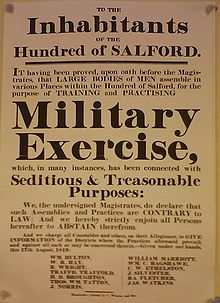 Notice "to the inhabitants of the Hundred of Salford", published by the magistrates the day after the massacre
Notice "to the inhabitants of the Hundred of Salford", published by the magistrates the day after the massacre
The government declared its support for the actions taken by the magistrates and the army. The Manchester magistrates held a supposedly public meeting on 19 August, so that resolutions supporting the action they had taken three days before could be published. Archibald Prentice, a radical manufacturer later to become editor of The Manchester Times, organised a petition of protest against the violence at St Peter's Field and the validity of the magistrate's meeting. Within a few days it had collected 4,800 signatures.[75] Nevertheless the Home Secretary, Lord Sidmouth, on 27 August conveyed to the magistrates the thanks of the Prince Regent for their action in the "preservation of the public peace".[6] That public exoneration was met with fierce anger and criticism. During a debate at Hopkins Street Robert Wedderburn declared "The Prince is a fool with his Wonderful letters of thanks ... What is the Prince Regent or King to us, we want no King – he is no use to us."[76] In an open letter, Richard Carlile said:
Unless the Prince calls his ministers to account and relieved his people, he would surely be deposed and make them all REPUBLICANS, despite all adherence to ancient and established institutions.[76]
For a few months following Peterloo it seemed to the authorities that the country was heading towards an armed rebellion. Encouraging them in that belief were two abortive uprisings, in Huddersfield and Burnley, during the autumn of 1819, and the discovery and foiling of the Cato Street Conspiracy to blow up the cabinet that winter.[77] By the end of the year, the government had introduced legislation, later known as the Six Acts, to suppress radical meetings and publications, and by the end of 1820 every significant working-class radical reformer was in jail; civil liberties had declined to an even lower level than they were before Peterloo. Historian Robert Reid has written that "it is not fanciful to compare the restricted freedoms of the British worker in the post-Peterloo period in the early nineteenth century with those of the black South African in the post-Sharpeville period of the late twentieth century".[78]
One direct consequence of Peterloo was the foundation of The Manchester Guardian newspaper in 1821 by a group of non-conformist Manchester businessmen headed by John Edward Taylor, a witness to the massacre.[25] The prospectus announcing the new publication proclaimed that it would "zealously enforce the principles of civil and religious Liberty ... warmly advocate the cause of Reform ... endeavour to assist in the diffusion of just principles of Political Economy and ... support, without reference to the party from which they emanate, all serviceable measures".[79]
Events such as the Pentridge Rising, the March of the Blanketeers and the Spa Fields meeting, all serve to indicate the breadth, diversity and widespread geographical scale of the demand for economic and political reform at the time.[80] Peterloo had no effect on the speed of reform, but in due course all but one of the reformer's demands, annual parliaments, were met.[81] Following the Great Reform Act of 1832, the newly created Manchester parliamentary borough elected its first two MPs. Five candidates including William Cobbett stood, and the Whigs, Charles Poulett Thomson and Mark Philips, were elected.[82] Manchester became a Municipal Borough in 1837, and what remained of the manorial rights were subsequently purchased by the borough council.
Commemoration
The Free Trade Hall, home of the Anti-Corn Law League, was built partly as a "cenotaph raised on the shades of the victims" of Peterloo.[83] Until 2007 the massacre was commemorated by a blue plaque on the wall of the present building, the third to occupy the site, now the Radisson Hotel. It was regarded as a less than appropriate memorial because it under reported the incident as a dispersal, and the deaths were omitted completely.[25] In a 2006 survey conducted by The Guardian, Peterloo came second to St. Mary's Church, Putney, the venue for the Putney Debates, as the event from British history that most deserved a proper monument.[84] A Peterloo Massacre Memorial Campaign was set up to lobby for a more prominent monument to an event that has been described as Manchester's Tiananmen Square.[85]
In 2007, Manchester City Council replaced the original blue plaque with a red one, giving a fuller account of the events of 1819. It was unveiled on 10 December 2007 by the Lord Mayor of Manchester, Councillor Glynn Evans.[86] Under the heading "St. Peter's Fields: The Peterloo Massacre", the new plaque reads:
On 16 August 1819 a peaceful rally of 60,000 pro-democracy reformers, men, women and children, was attacked by armed cavalry resulting in 15 deaths and over 600 injuries.[87]
In 1968, in celebration of its centenary, the Trades Union Congress commissioned British composer Sir Malcolm Arnold to write the Peterloo Overture.[88] Other 20th-century musical commemorations include "Ned Ludd Part 5" on electric folk group Steeleye Span's 2006 album Bloody Men, and Rochdale rock band Tractor's suite of five songs written and recorded in 1973, later included on their 1992 release Worst Enemies.
See also
- History of Manchester
- Unreformed House of Commons
- List of massacres in the United Kingdom
Footnotes
- ^ "Currency converter". The National Archives. http://www.nationalarchives.gov.uk/currency/. Retrieved 8 April 2008.
- ^ a b Reid (1989), p. 28.
- ^ "The Great reform Act". BBC News. 19 May 1998. http://news.bbc.co.uk/1/hi/uk_politics/talking_politics/95699.stm. Retrieved 26 March 2008.
- ^ a b c Frangopulo (1977), p. 30.
- ^ a b Hernon (2006), p. 22.
- ^ a b Farrer, William; Brownbill, John (2003–2006) [1911]. "The city and parish of Manchester: Introduction". The Victoria history of the county of Lancaster. - Lancashire. Vol.4. University of London & History of Parliament Trust. http://www.british-history.ac.uk/report.aspx?compid=41404. Retrieved 27 March 2008.
- ^ Glen, Robert (1984). Urban workers in the early Industrial Revolution. London: Croom Helm. pp. 194–252. ISBN 0-7099-1103-3.
- ^ Reid (1989), p. 115.
- ^ Reid (1989), p. 116.
- ^ Reid (1989), p. 122.
- ^ Reid (1989), p. 118.
- ^ a b c d e f g McPhillips (1977), pp. 22–23.
- ^ a b Reid (1989), p. 125.
- ^ Reid (1989), p. 123.
- ^ Frangopulo (1977), p. 31.
- ^ a b Frangopulo (1977), p. 33.
- ^ a b c d e f Bush (2005), p. 11.
- ^ a b c d Marlow (1969), p. 118.
- ^ a b Marlow (1969), pp. 120–121.
- ^ a b Frow (1984), p. 7.
- ^ Reid (1989), p. 145.
- ^ Marlow (1969), p. 119.
- ^ Reid (1989), pp. 152–153.
- ^ Reid (1989), p. 88.
- ^ a b c Wainwright, Martin (13 August 2007). "Battle for the memory of Peterloo: Campaigners demand fitting tribute". The Guardian. Guardian News and Media Ltd.. http://www.guardian.co.uk/uk/2007/aug/13/britishidentity.artnews. Retrieved 26 March 2008.
- ^ Prentice (1851), p. 160.
- ^ Reid (1989), p. 136.
- ^ Reid (1989), p. 138.
- ^ Marlow (1969), p. 95.
- ^ Marlow (1969), p. 125.
- ^ Reid (1989), p. 148.
- ^ Bamford (1841) Chapter XXV
- ^ Bush (2005), p. 19.
- ^ Marlow (1969), pp. 119–120.
- ^ Reid (1989), p. 161.
- ^ Reid (1989), pp. 162–163.
- ^ Marlow (1969), p. 129.
- ^ a b Reid (1989), p. 167.
- ^ Reid (1989), p. 166–167.
- ^ a b c Frow (1984), p. 8.
- ^ Reid (1989), p. 168.
- ^ Reid (1989), p. 156.
- ^ Reid (1989), p. 170.
- ^ Poole (2006), p. 262.
- ^ Reid (1989), p. 185.
- ^ a b Reid (1989), p 180.
- ^ Walmsley (1969), p. 214.
- ^ Reid (1989), p. 175.
- ^ Reid (1989), p. 181.
- ^ Reid (1989), pp. 186–187.
- ^ a b c d e f g h i j k l m n o p q r Marlow (1969), pp. 150–151.
- ^ Reid (1989), p. 187.
- ^ a b Bush (2005), p. 12.
- ^ Bush (2005), p. 1.
- ^ Bush (2005), p. 31.
- ^ Bush (2005), p. 65.
- ^ In 1816 Lily-hill lay within the parish of Bury. In 1866 it was incorporated into the new town of Whitefield. See:
Bury Metropolitan Borough Council. "Whitefield & Unsworth Local Area Partnership". bury.gov.uk. http://www.bury.gov.uk/LocalAreaPartnerships/WhitefieldUnsworth/default.htm. Retrieved 1 April 2008. - ^ Bush (2005), p. 74.
- ^ Bush (2005), p. 77.
- ^ Bush (2005), p. 79.
- ^ Bush (2005), p. 86.
- ^ Bush (2005), p. 90.
- ^ Bush (2005), p. 92.
- ^ Bush (2005), p. 105.
- ^ Frow (1984), p. 8 lists Jones as injured, not that she died.
- ^ Bush (2005), p. 115.
- ^ Bush (2005), p. 139.
- ^ a b Marlow (1969), p. 6.
- ^ Poole (2006), p. 254.
- ^ Reid (1989), p. 201.
- ^ Donald, Diana (1989). "The power of print: graphic images of Peterloo" (PDF). Manchester Region History Review 3: 21–30. http://www.mcrh.mmu.ac.uk/pubs/pdf/mrhr_03i_marlow.pdf.
- ^ Sandy, Mark (20 September 2002). "The Mask of Anarchy". The Literary Encyclopedia. The Literary Dictionary Company Ltd. http://www.litencyc.com/php/sworks.php?rec=true&UID=213. Retrieved 1 April 2008.
- ^ Bush (2005), pp. 30, 35.
- ^ Reid (1989), pp. 203–204.
- ^ Reid (1989), p. 195.
- ^ a b Poole (2000), p. 154.
- ^ Poole (2006), p. 272.
- ^ Reid (1989), p. 211.
- ^ "The Scott Trust: History". Guardian Media Group. http://www.gmgplc.co.uk/ScottTrust/History/tabid/193/Default.aspx. Retrieved 26 March 2008.
- ^ Davis (1993), pp. 32–33
- ^ Reid (1989), p. 218.
- ^ Prentice (1853), p. 25.
- ^ Pickering and Tyrrell (2000), p. 204.
- ^ Hunt, Tristram; Fraser, Giles (16 October 2006). "And the winner is ...". The Guardian. London: Guardian News and Media Ltd.. http://www.guardian.co.uk/artanddesign/2006/oct/16/heritage.britishidentity. Retrieved 25 March 2008.
- ^ Hobson, Judy (17 August 2007). "Remember the Peterloo massacre?". BBC News. http://news.bbc.co.uk/1/hi/uk/6950666.stm. Retrieved 26 March 2008.
- ^ Manchester City Council (10 December 2007). "Peterloo memorial plaque unveiled". manchester.gov.uk. Archived from the original on 14 March 2008. http://web.archive.org/web/20080314191448/http://www.manchester.gov.uk/site/scripts/news_article.php?newsID=3246. Retrieved 26 March 2008.
- ^ Ward, David (27 December 2007). "New plaque tells truth of Peterloo killings 188 years on". The Guardian. London: Guardian News and Media Ltd.. http://www.guardian.co.uk/uk/2007/dec/27/past.politics. Retrieved 25 March 2008.
- ^ Jackson (2003), pp. 133–134.
Bibliography
- Bamford, Samuel (1841). Passages in the life of a radical. London: T. Fisher Unwin. ISBN 0192814133. http://domain1041943.sites.fasthosts.com/bamford/c_radical_(8).htm#XXV.
- Bush, Michael (2005). The Casualties of Peterloo. Carnegie Publishing. ISBN 1-85936-125-0.
- Davis, Prof. Mary (1993). Comrade or Brother? The History of the British Labour Movement 1789–1951. London: Pluto Press. ISBN 0-7453-0761-2.
- Foot, Paul (2005). The Vote: How It Was Won and How It Was Undermined. London: Viking. ISBN 0-670-91536-X.
- Frangopulo, N. J. (1977). Tradition in Action: The Historical Evolution of the Greater Manchester County. EP Publishing, Wakefield. ISBN 0-7158-1203-3.
- Frow, Edmund & Ruth (1984). Radical Salford: Episodes in Labour History. Radcliffe: Neil Richardson. ISBN 0-907511-49-X.
- Hernon, Ian (2006). Riot!: Civil Insurrection from Peterloo to the Present Day. Pluto Press. ISBN 0-7453-2538-6.
- Jackson, Paul (2003). The Life and Music of Sir Malcolm Arnold:The Brilliant and the Dark. Ashgate Publishing Ltd. ISBN 1-85928-381-0.
- Marlow, Joyce (1969). The Peterloo Massacre. Rapp & Whiting. ISBN 0-85391-122-3.
- Pickering, Paul A.; Tyrrell, Alex (2000). The People's Bread: A History of the Anti-Corn Law League. Leicester University Press. ISBN 0-7185-0218-3.
- McPhillips, K. (1977). Oldham: The Formative Years. Neil Richardson. ISBN 1-85216-119-1.
- Poole, Robert (2006). "'By the Law or the Sword': Peterloo Revisited". History 91 (302): 254–276. doi:10.1111/j.1468-229X.2006.00366.x.
- Poole, Steve (2000). The Politics of Regicide in England, 1760–1850. Manchester University Press. ISBN 0-7190-5035-9.
- Prentice, Archibald (1851). Historical Sketches and Personal Recollections of Manchester: Intended to illustrate the progress of public opinion from 1792 to 1832 (1970 reprint of the 2nd ed.). Routledge. ISBN 0-7146-1353-3.
- Prentice, Archibald (1853) (PDF). History of the Anti-corn-law League. W. & F. G. Cash. ISBN 1432689657. http://books.google.com/?id=cz0IAAAAQAAJ.
- Read, Donald (1973). Peterloo: the "massacre" and its background. Manchester University Press. ISBN 0-678-06791-0.
- Reid, Robert (1989). The Peterloo Massacre. William Heinemann Ltd. ISBN 0-434-62901-4.
- Walmsley, Robert (1969). Peterloo: The Case Re-opened. Manchester University Press. ISBN 0-7190-0392-X.
External links
Listen to this article (info/dl)
This audio file was created from a revision of Peterloo Massacre dated 17 April 2008, and does not reflect subsequent edits to the article. (Audio help)More spoken articles- BBC Radio 4 In Our Time broadcast about the Peterloo Massacre.
- The Peterloo Massacre Memorial Campaign.
- UK Schoolnet information about the Peterloo Massacre.
- Timelines TV - history, documentary and television on the web.
- Modern day location of the massacre
Riots in England Pre-20th century 1189 Massacre of the Jews · 1196 Poor riot · 1355 St Scholastica Day riot · 1381 Peasants' Revolt · 1517 Evil May Day · 1668 Bawdy House Riots · 1769 Spitalfield Riots · 1780 Gordon riots · 1791 Priestley riots · 1793 Bristol Bridge riot · 1809 Old Price Riots · 1816 Spa Fields riots · 1816 Ely and Littleport riots · 1819 Peterloo Massacre · 1830 Swing riots · 1831 Queen Square riots (Bristol) · 1832 Days of May · 1838 Battle of Bossenden Wood · 1896 Newlyn riots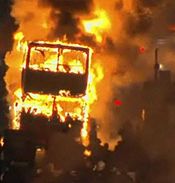
Pre-1970s 1907 Brown Dog riots · 1910 Tonypandy riots · 1919 Epsom riot · 1919 Battle of Bow Street · 1919 Luton Peace Day riots · 1932 Old Market riot (Bristol) · 1936 Battle of Cable Street · 1958 Notting Hill race riots1970s 1980s 1980 St. Pauls riot · 1981 England riots · 1981 Brixton riot · 1981 Chapeltown race riot · 1981 Toxteth riots · 1981 Moss Side riot · 1981 Handsworth riots · 1985 Handsworth riots · 1985 Brixton riot · 1985 Broadwater Farm riot · 1987 Chapeltown race riot · 1989 Dewsbury race riot1990s 1990 Poll Tax riots · 1990 Strangeways Prison riot · 1991 Meadow Well riots · 1991 Handsworth riots · 1992 Hartcliffe riot (Bristol) · 1995 Manningham riot · 1995 Brixton riot2000s 2001 England riots: 2001 Bradford riots · 2001 Oldham race riots · 2001 Harehills riot · 2005 Birmingham race riots2010s Related articles Death of Mark Duggan · House of Reeves · List of riots · List of riots in Leeds · List of riots in London · Death of Keith Blakelock · Public Order Act · Riot · Riot Act · Riot control · Scarman reportCategories:- Conflicts in 1819
- 1819 in England
- Massacres in England
- Activism
- 19th-century military history of the United Kingdom
- Massacres committed by the United Kingdom
- Political history of the United Kingdom
- History of Manchester
- Suffrage campaign in the United Kingdom
- Political scandals in the United Kingdom
- Protest-related deaths
Wikimedia Foundation. 2010.

